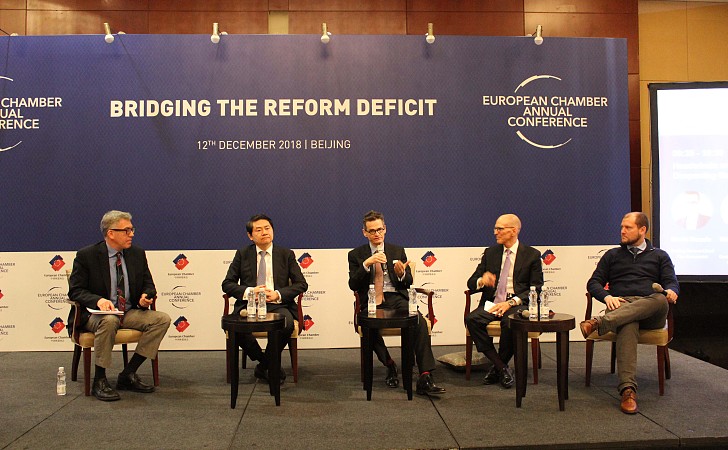Headwinds or Tailwinds? Deepening Reform in the Trade War Era Go back »
2019-01-10 | All chapters

From left to right:
Michael J Jordan, CGTN Commentator & Global Communications Specialist (moderator)
Wang Huiyao, President, Centre for China and Globalisation
David Rennie, Beijing Bureau Chief, the Economist
William Zarit, Senior Counsellor, the Cohen Group
Andrew Polk, Co-founder, Trivium/China
Speakers began with a discussion on the definition of meaningful reform in the context of China’s opening up agenda in recent years. Opinions clashed over the pace of China’s reform after President Xi delivered his speech at Davos in January 2017, with some claiming that the speed of change has been more than sufficient, while others argued to the contrary. The panellists took the debate a step further and compared the differing meanings of “reform” in the eyes of the west compared to the meaning in the Chinese context. This led to a general consensus of the kind of reform that is needed by both the Chinese economy and the many global actors that are dissatisfied about the openness and fairness of China’s markets.
The discussion then moved to what this means for businesses, as well as governments. For businesses, some argued that now is a great time to increase exposure to the China market, as the government is currently keen to steer the narrative towards successful examples of investment, especially for 100 per cent foreign ownership, while also shining light on companies receiving fair treatment; all good news for international companies. Governments, on the other hand, have reason for concern and have shifted to a new approach in dealing with China. The US, in particular, has shifted from approaching challenges faced by its companies on a case-by-case basis to a more overarching and structural approach. The American negotiators, as one speaker reported, “no longer come with lists of specific cases of, for example, forced tech transfers, but instead demand that China stop ‘stealing’ American IP”.
Panelists ended the conversation by examining the positive or negative pressure that the US-China tariff exchange has had on China’s reform agenda. The argument broke down into two main camps, those who think that the US pressure has pushed China to open up more quickly, and those who think that those actions have led China to withhold some of its more ambitious reforms to use as bargaining chips with the US. Regardless of their stances on the effects of the trade war, all speakers expressed cautious optimism, some citing the willingness of the Trump administration to cut a deal and others arguing that China will reform because it is good for China. However, most came to a consensus that there are still very real risks that that trade conflict will escalate and possibly even mingle with greater geo-political frictions.
See the other two panels:
China's Innovation Drive: Top-Down and Bottom-Up, the second panel, explored the comparative value of the competing approaches to innovation in China that are coming from the state-directed and market-driven ends of the spectrum.
Economic Outlook and the Impact for Business, the third panel, brought together top economists to consider the probable macro trends that we can expect to see in 2019 and what that will mean for business, trade conflict, and growth.